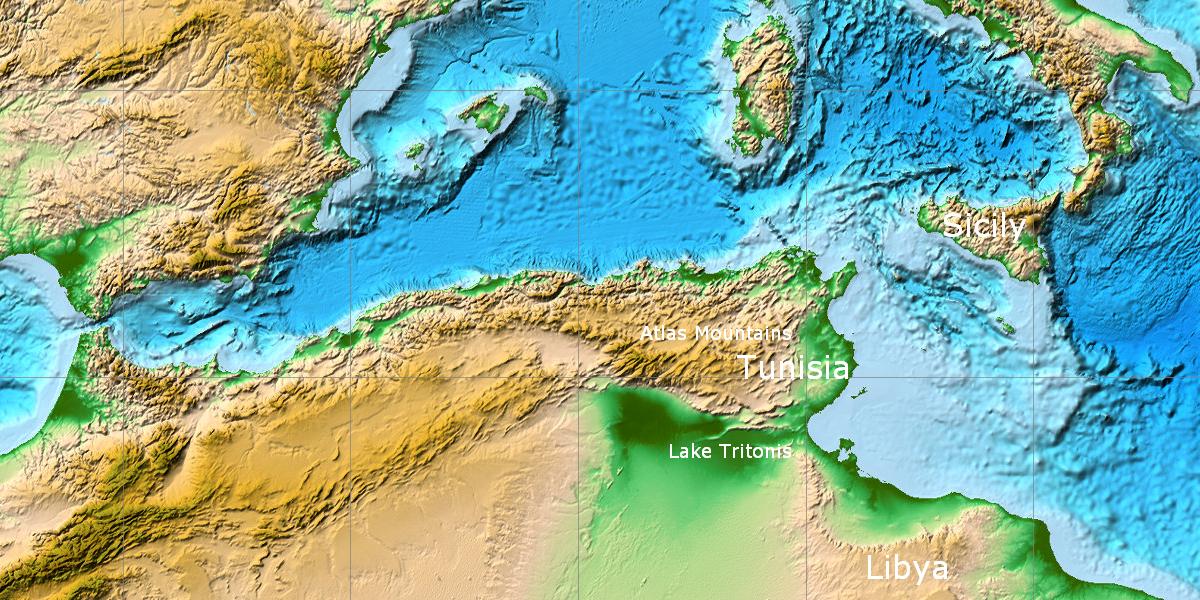Both Plato and Diodorus gave geographical indications regarding the location of Atlantis.
Since Plato’s indications were not relevant to his propaganda issues, one could imagine that the geographical details of the dialogues maintained some unmodified elements of the original Egyptian myth. Questionable as this is, a summary of Plato’s main clues is reported below.
Nine thousand years before the visit of Solon to Sais (Tim. III 23.e; Crit. III 108.e), the Atlantic Sea [A1] was navigable (Crit. III 109.a) and, in front of the Pillars of Hercules (Tim. III 24.e), was an island larger than Libya and Asia combined. This island was close to other islands and, by ‘hopping’ between them, one could reach the continent that enclosed the vast ocean. The ‘capital’ of this empire was a small island which ruled over the entire archipelago. On the continent, Atlantis ruled Europe up to Thyrrenia and Libya (Africa) from the Pillars to the Egyptian border (Tim. III 25.b). The main island of the archipelago had a large plain, three thousand stadia (approximately, 550 km) long and two thousand stadia (350 km) wide, [A2] surrounded by northern mountains and by a southern channel that ended in the open sea (Crit. X 118.b), with rivers, lakes, mountains and marshes, two harvests per year (Crit. X 118.e), elephants (Crit. VI 114.e) and exotic fruits (Crit. VI 115.b). Its first king was Atlas (Crit. VI 114.b), who ran the country perfectly, following commendable political principles, second only to those of Athens. But when Atlantis wanted to conquer Egypt and Athens, the heroic Athenians resisted and defeated it, freeing Egypt, which in the meantime had been subjugated, as well. A little later, a violent earthquake and a flood destroyed Atlantis in a day and a night, leaving an impenetrable swamp in place of the island (Tim. III 26.d); Athens also perished in the cataclysm.

Diodorus too provided some geographical hints about Atlantis. According to him many generations before the Trojan War, the refined Atlanteans were subjugated by the Libyan Amazons (Book III, 54, 1). In fact, long before the Amazons of classical tradition (who lived along the river Thermodon, on the southern coast of the Black Sea – author’s note), Libya was inhabited by other Amazons originating from an island on Lake Tritonis [A3] (Book III, 53, 4), from which they dominated the surrounding region (Figure A1). [A4]
The Atlanteans surrendered en masse to the Amazon queen Myrina when Cernę, the only city of theirs that had tried to resist, was completely destroyed (Book III, 54, 5). According to Diodorus, the Atlanteans, who had many cities and lived in a fertile region on the coast (Book III, 56, 2), were an extremely refined and pious people, because the gods had been born among them. Their first king had been Uranus, a god who had elevated them from their bestial state and taught them agriculture (Book III, 56, 3).
Uranus had several wives, including Titea, later called Gaea, who bore him eighteen children: the Titans. One of these, Hyperion, succeeded his father and, on his death, the kingdom was divided between his brother Kronos and his nephew Atlas (son of another brother, Iapetus). Atlas took the coastal and the mountainous regions, giving his name not only to the mountains, but also to the inhabitants of the whole kingdom (Book III, 60, 1). According to the Cretans, Kronos reigned over Sicily, Libya and Italy (Book III, 60, 3).
Since 2018 this site has been accessed times;
Atlantis has been visited times.